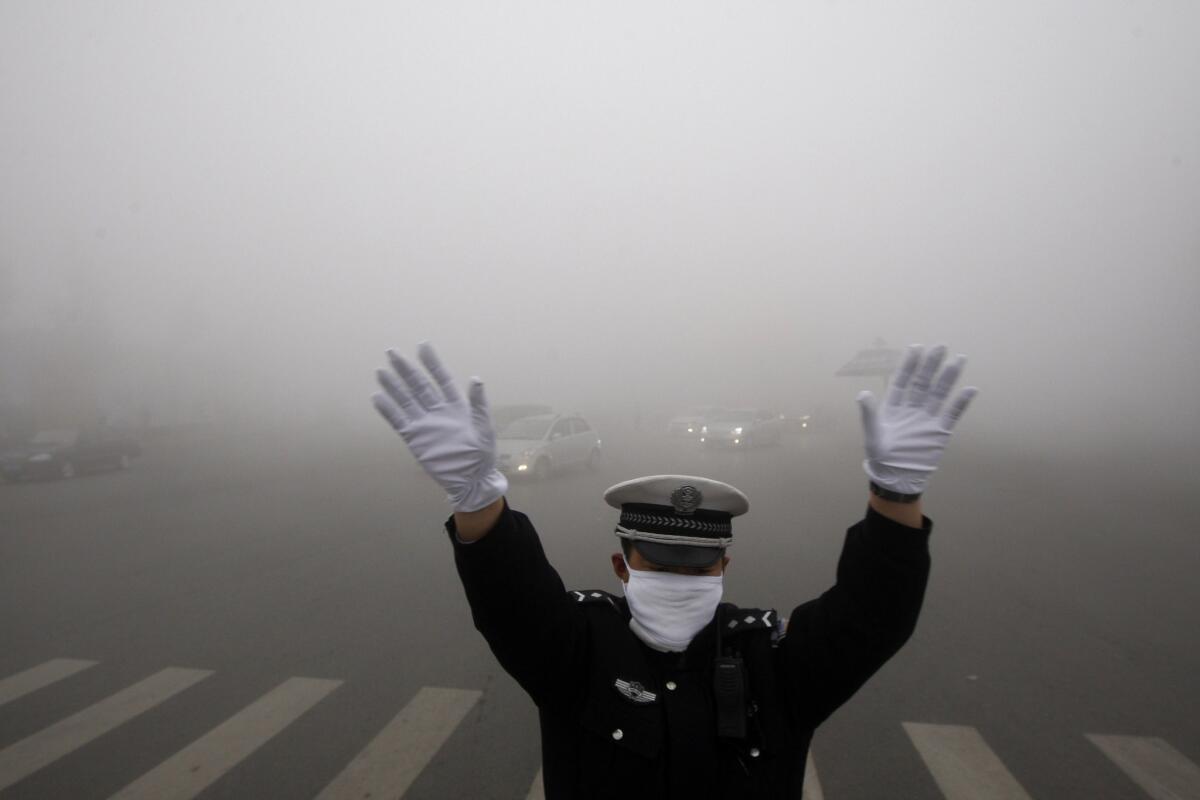Beijing’s smog makes Los Angeles air look good

- Share via
Reporting from Beijing — How does a normal day in Beijing compare with one in Los Angeles?
The answer, it turns out, is both simple and complex.
Los Angeles’ skies are among the most foul in the United States: In the American Lung Assn.’s 2014 national State of the Air survey, the L.A.-Long Beach area ranked worst in terms of ozone concentrations and third worst in terms of particulates as measured by the standard known as PM2.5, which captures particles so small they can be seen only with an electron microscope.
But if L.A. were in China, it would be cleaner than all 74 major cities tracked in 2013 by the Chinese Ministry of Environmental Protection, based on PM2.5 levels.
According to U.S. standards, an average annual PM2.5 reading of 12.4 or below is considered “good.” Downtown L.A.’s average annual reading for 2013 was 18, according to the South Coast Air Quality Management District.
Even the cleanest Chinese cities are dirtier. The cleanest in China’s 2013 report, Haikou, had an average annual PM2.5 reading of about 26. The filthiest, Xingtai, had a reading six times higher. Beijing, the 13th dirtiest Chinese metropolis, had a value of 90.
China didn’t begin releasing the ranking of 74 cities until 2013. But a slightly longer-term direct comparison between Beijing and L.A. is possible, thanks to U.S. Embassy data, which has been collected since 2008.
The results might make Angelenos gasp.
From February 2009 to December 2013, Beijing’s worst one-day average reading was 569 on Jan. 12, 2013; L.A.’s was 79 on Dec. 9, 2012. In the same period, Beijing had 48 days with an average daily reading in excess of 300, considered by both China and the United States to be “hazardous.”
OK, so, China’s pollution is bad, but is it as severe as Los Angeles’ was decades ago?
Unfortunately, comparing L.A. smog of 50 years ago to Beijing’s current air quality is at best an educated guessing game, many experts say. That’s because nobody measured PM2.5 back in the 1960s.
“Comparing California 30 years ago to China today is apples and oranges,” says Eugene Leong, an air pollution expert and former executive director of the Assn. of Bay Area Governments who has been teaching at Peking University for several years. “How bad was PM2.5 in California in the ‘60s, ‘70s and ‘80s? We don’t know. … Was it as bad as what China is experiencing now? My educated guess is probably not as bad.”
C. Arden Pope, an economics professor at Brigham Young University and an expert in environmental science, says it’s hard to believe that average annual PM2.5 readings in Los Angeles ever approached 100. “Beijing [today] is at least twice as bad as L.A. at its worst,” he says.
Complicating the comparison further is the fact that the biggest problem L.A. had 50 years ago was not particulate matter but ozone, attributable primarily to vehicle exhaust.
“L.A. had severe, severe problems with ozone. Beijing has problems with ozone, but nothing like L.A. did,” says Dan Jaffe, a physical sciences professor at the University of Washington-Bothell.
So which poison would you rather breathe, the high ozone in L.A. of the ‘60s or the high PM in Beijing today?
“It’s a tough question but I think most of the health data would suggest that the PM levels of the kind that Beijing sees now are probably a bigger health threat,” Jaffe says. Both ozone and particulate matter contribute to premature mortality, he noted, but the effects of particulate matter on the cardiovascular system have been especially well-established.
A study published last year concluded that outdoor air pollution contributed to 1.2 million premature deaths in China in 2010, or the loss of 25 million healthy years of life per year.
Still, Pope says there is some mildly good statistical news for those in China’s dirtiest places. Once exposure passes a certain level, perhaps around an annual average PM2.5 level of 100, he said, the health risks stop going up in a linear fashion. In other words, living in a city where the PM2.5 reading averages 300 isn’t twice as dangerous as routine exposure to a 150 level.
Lately, China has witnessed increasing numbers of well-off young urbanites opting out of the nation’s most polluted cities, relocating to more rural areas in search of both a more healthful environment and a less stressful way of life.
“Our bodies are really remarkably resilient,” Pope said. “We can be exposed to this stuff. Our risk goes up. But if we quit breathing the bad air, it appears our bodies recuperate. It will go away fairly rapidly after you leave the exposure.”
Unfortunately, for tens millions of people, moving out of China’s smoggiest cities isn’t an option.
Makinen reported from Beijing and Smith from Los Angeles
More to Read
Sign up for Essential California
The most important California stories and recommendations in your inbox every morning.
You may occasionally receive promotional content from the Los Angeles Times.














